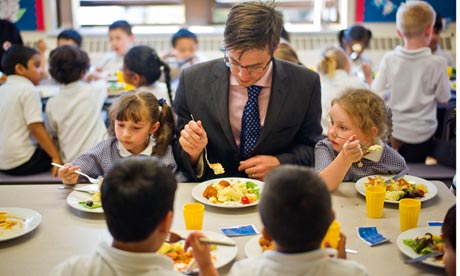
For anyone with distasteful memories of school lunches from the 1980s and 1990s, sitting down to lunch with the pupils and staff at the Reach academy in Feltham, west London, is eating in a different era.
For one thing, the food tastes great: everything is freshly prepared on the premises, overseen by chefs who talk to students and share their favourite recipes with parents. Banished from the menu are the chips-with-pizza staples, delivered in a van and heated up to long queues of children, served alongside over-boiled vegetables and the grim inevitability of instant mashed potatoes.
In their place are Moroccan lamb tagines and roasted vegetables, Thai curries and salade niçoise, with strawberry trifle or watermelon for dessert. And all for £2 a day. The school has also taken the unusual step of stopping parents from sending packed lunches to school.
"We've had almost no pushback. Parents have been very happy," said Ed Vainker, the headteacher. "I think when they hear that I eat the food, that all the staff eat the food, and that we all sit together and socialise and get to know each other as individuals, they are happy to proceed."
It's a policy that some, including restaurateurs John Vincent and Henry Dimbleby, who have conducted a government-commissioned review of school lunches, would like to see go nationwide. Making school lunches compulsory means more money is available for a school to spend on them, improving the quality of the ingredients while lowering the unit cost. It also stops parents from packing unhealthy snacks such as crisps or sweets.
The quality of the school's food has been praised by, among others, the London mayor, Boris Johnson, who said after visiting: "This is the best school dinner I've ever had." It's a model of the revolution in school food that Jamie Oliver hoped to start, and that Vincent and Dimbleby hope to encourage.
Staff at the Reach, a free school that opened in September last year, say lunch isn't just about food; it's an important part of the school's ethos. "Lunch is a focal point of the day here, where children can share their ideas and their jokes," said Lydia Gibbs, the school's lead reception teacher.
That's true for the staff as well, with a teacher sitting at each table and eating the same food as the children, on hand to help the five-year-olds struggling with knives and forks, and gently encourage others to at least try the green beans and salads.
For the teachers, being present for lunch every day means giving up the peace and quiet of the staff room. "That's a commitment that we are prepared to make," said Jayne Watkinson, a reception teacher.
At Reach, unlike many other schools, lunch is served at the table – meaning there are no long queues of bored and hungry children clutching trays. The pupils sit in small groups, with the older children able to dish up their own food.
"Lunch at my last school wasn't a fun time, with lots of queueing. Here, lunch is calm," said Nicky McLachlan, the school's progression leader, responsible for charting the pupils' progress.
Even on a warm summer's day, with the playground beckoning, the reception class children cheerfully chatted about dinosaurs and the state of Iraq while eating jelly for dessert before tidying up and waiting to be let out. The fact that they were in no rush to leave the table suggests they enjoy it. "Everyone sits down together and everyone eats together. We all start at the same time," said Gibbs.
For some of the pupils, that in itself was a novelty, including those from homes without a table to dine on, or in some cases a family to eat with.
"For a lot of the children, it was very different for them," said Gibbs. "You can see a big change from the start of the year."
With only two classes to feed at the moment, Reach Academy has an easier time than older and bigger schools. But Reach will eventually be an "all-through" school from nursery to sixth form, with 860 pupils. Vainker is adamant that school lunches will remain a priority.
"Some schools make a lot of money out of their school lunches, or school caterers do," said Vainker. "We're much more interested in the experience and the quality of the food than we are in potentially making £70,000 out of lunch for children over the year. We think it is much more important, much more value, to have excellent food and have a really positive lunchtime experience."
Advice from the 'lunchbox doctor'
Jenny Tschiesche, a nutritionist and the author of Not Just Sandwiches – five ways to improve your child's lunchbox, says that packed lunches don't deserve the obloquy they have attracted, and that many parents want the choice, especially those who have children with allergies or food intolerances. The ideal school lunchbox should contain six elements: carbohydrates, protein, calcium, fruit, vegetables and a drink.
Here is Tschiesche's recommendation for a fast, easy to acquire and nutritiously balanced lunchbox:
• Pasta salad with vegetables and meat
• Pot of low-sugar yoghurt
• Fresh fruit
• Drink of water or milk
• Dried fruit or trail mix rather than cereal bars
• Fruit juice or a fruit smoothie could be substituted for fresh fruit
• Other alternatives include hummus and cut-up carrot batons

